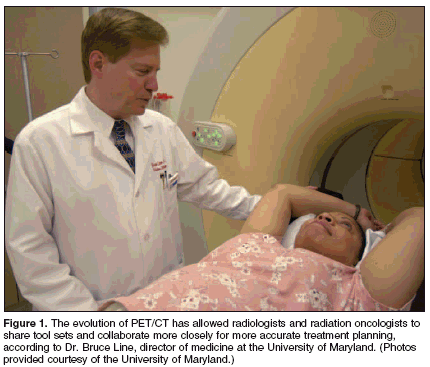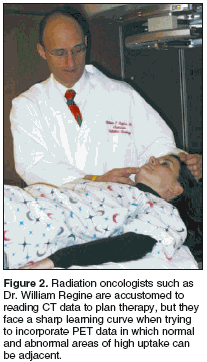PET/CT Is Fast Reshaping Cancer Management,Drawing Two Specialties Together
This special supplement to Oncology News International comprises expertcommentary and selected reports from the 2004 meetings of RSNA andASTRO about new imaging techniques, with a focus on state-of-the-art magneticresonance imaging, positron emission tomography, computed tomography,and complementary modalities for improving the diagnosis, staging, andtreatment of a variety of cancers. Evident in these reports is the increasingcollaboration between the specialties of radiation oncology and diagnosticradiology as imaging technology continues to evolve.
CHICAGO-Now that advancedimaging techniques are providingexquisitely detailed informationabout the location and bioactivityof tumors and metastases, the perspectivesof radiologists and radiationoncologists are converging, as evidentin interviews with and reports frompresenters at the 90th Scientific Assemblyand Annual Meeting of theRadiological Society of North America(RSNA). Radiation oncologists arepaying greater attention to manifestationsof focal and systemic malignancies,and nuclear medicine physiciansare narrowing their identification ofmalignancies to the smallest volumesthat may be targeted with high-doseboost radiotherapy.PET in RT PlanningUntil recently, use of positron emissiontomography (PET) imaging toassess patients with cancer was confinedto distinguishing benign frommalignant disease and staging malignantneoplasms. When used with CT,however, PET has been critical in increasingthe accuracy of cancer staging.It has improved the sensitivityand specificity of staging patients withnon-small-cell lung cancer (NSCLC),for instance, from 60% to 85%, andhas significantly strengthened prognosticstratification.A role for PET in planning radiotherapyis steadily emerging. According to a review article by Jeffrey Bradley,MD, an assistant professor of radiationoncology at Washington UniversitySchool of Medicine, St. Louis,Missouri, and colleagues, describingefforts to implement biologic targetvolumes in radiotherapy planning forpatients with NSCLC, use of PET incombination with CT has led to changesin the shape of radiation portals andvolumes, improved demarcation of tumors in the presence of atelectasis,and enlargement of portions of theradiation beam aperture (Bradley JD,Perez CA, et al: J Nucl Med 45(Supp1):965-1015, 2004).While PET has significantly increasedtarget volumes for radiotherapyby identifying occult areas of tumorinvolvement or additionalregional nodal disease, Dr. Bradley andhis associates stated, it has substantiallydecreased target volumes by identifyingareas of lung consolidation orenlarged lymph nodes with littleradioactive uptake.In reviewing studies from 1996through 2003, the investigators foundthat PET altered radiation treatmentplanning in up to 45% of patients. Inhis own experience with 24 lung cancerpatients who had 3D conformalradiotherapy, Dr. Bradley concludedthat PET significantly altered treatmentvolume for 14 patients by findingpreviously unsuspected nodal diseasein 10 patients, locating a separatetumor focus in the same lung lobe inone patient, and distinguishing tumorfrom atelectasis in three patients."In about 10% to 20% of patientswe find metastatic disease, and PETsignificantly changes the treatmentprogram for a patient with metastasis,"he said. "In patients with no metastaticdisease, PET changes tumorvolumes for radiation therapy 30% to50% of the time. When you add thosetwo percentages together, there is asignificant change based on PET imaging,"he said.For example, at the 2004 RSNAmeeting, radiologist William Lavely,MD, from Johns Hopkins University,Baltimore, Maryland, reported thatPT/CT changed the calculation of grosstumor volume for six patients (abstractSSK26-05). Tumor volumes derivedfrom PET/CT were 17% largerthan those obtained from CT aloneand 14% larger than those based onPET.Limitations of PETHowever, there is no standardizedway of interpreting functional imagingdata from one clinical setting toanother. As a result, calculations ofradiation planning target volumeshave varied from 24% to 76% in differentstudies. Normal structures andmetabolic processes have often beenconfused with abnormal ones. Interpretationsof PET images have beencomplicated by false positives, such asinflammatory plaques within the aorta,fulminating tuberculosis, pleuralreactions, scarring after radio- or chemotherapy,and motion effects. Tumorshave been known to move by asmuch as 3 cm in one dimension andalong the x, y, and z trajectories, Dr.Bradley said.Hardware and software are helpingto correct these problems. At the46th annual meeting of the AmericanAssociation of Physicists in Medicine,in Pittsburgh, Pennsylvania, investigatorsfrom Washington University,St. Louis, Missouri, and The Universityof Texas M.D. Anderson CancerCenter, Houston, reported on PET/CT 4D scanning, which can correctfor image blurring and other distortionscaused by lung and heart motion.Further, a research team fromMassachusetts General Hospital is testingsoftware that adjusts radiation doseby tracking tumor motion on 4D scans.(See the report on gated 4D PET/CTon page 10).Despite recent advancements inPET/CT imaging, presenters emphasized,the technology demands the focusand expertise of two specialties totake full advantage of its potential.Interpreting PET Scans forTreatment PlanningIn the case of lung cancer, it is notuncommon for a tumor to lie adjacentto a collapsed area of the lung, andthese two features are almost indistinguishable,noted William F. Regine,MD, professor and chair of the departmentof radiation oncology at theUniversity of Maryland, Baltimore.Consequently, nuclear medicinephysicians and radiation oncologistsare working closely to coordinate thereading of scans. At Cedars Sinai MedicalCenter in Los Angeles, nuclearmedicine physicians take radiation oncologists step by step through PETscan review, to help them differentiatetrue malignancies from normal variationsin metabolic activity and hypermetabolicconditions that are not relatedto cancer.Nuclear medicine physicians alsoprovide counsel about the pitfalls andlimitations of functional imaging, saidAlan D. Waxman, MD, co-chair of theMark Taper Foundation Imaging Centerat Cedars Sinai. Questions thatarise, he said, include that of whatconstitutes areas of increased FDGuptake caused by secondary infectionor inflammation rather than malignancy;why the heart appears in variousforms in many of the fields thatmay be targeted for irradiation andwhat should be done about it; andwhy inflammatory plaques in the aortaare sometimes mistaken for involvedlymph nodes.

Radiation oncologists are guidedby the principle that the smaller thevolume targeted for therapy, the higherthe dose of radiation that can be deliveredto kill the greatest number ofcancer cells while sparing as manynormal cells as possible. Helping thesespecialists drill down to the smallesttreatment volume requires that nuclearmedicine physicians pay closeattention to margins of error: whetheran area of increased metabolic activitylies too close to the spinal cord to takethe chance that it will be included inthe irradiation field, whether the motionof the heart is too variable toclearly demarcate the edge of a tumornear the left ventricle, and whetherthere is an 80% chance that a malignancyhas metastasized to the mediastinumor the probability is high thata lymph node is most likely normal.Compromising these decisions is a lackof understanding about the meaningof functional images.

"PET has changed our radiationtreatment targets, but we have notestablished a way to threshold the PETso the images appear the same. Wehave not really addressed the fact thatPET gives you much more informationthan just volumes; it can give youthe degree of FDG uptake or the standarduptake value. But we are juststarting to learn what that informationmay mean in terms of patients'prognosis," Dr. Bradley said.Fine-Tuning RadiationDeliveryRadiation oncologists and nuclearmedicine physicians also are at thebeginning stages of using yttriumimpregnatedglass or ceramic beads todeliver high doses of radiation to hepatictumors and limit toxicity to normalliver tissue. To be sure the radioactivebeads lodge only in liver tumors,nuclear medicine physicians have beenconducting full-body surveys of thedeposition of macroaggregates of albumin,verifying that the albumin iscollecting in the capillary vessels ofthe liver and not in collateral vesselsfeeding the gut, stomach, or lungthrough collateral circulation.PET/CT is central to the process, asit assesses the 3D distribution of a testdose of a tracer and therefore can beincorporated in treatment planningalgorithms, commented Bruce R. Line,MD, professor of diagnostic radiologyand director of the division of nuclearmedicine at the University of Maryland,Baltimore.As technology moves radiationtherapy beyond the external beam, thetwo specialties are intensifying effortsto educate each other. Radiation oncologistsare becoming schooled inmolecularly based imaging and molecularlyguided therapeutic techniques,and radiologists are becomingmore practiced in applying molecularimaging to calculate radiation doses."These two specialties have a lot tolearn from each other," Dr. Line said.The reason information exchange isincreasing between these groups, headded, is that "the technology is movingin a direction that makes it possiblefor radiologists and radiation oncologiststo use each other's tool setsto solve problems in a more sophisticatedway."